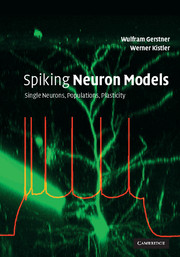Book contents
3 - Two-dimensional neuron models
Published online by Cambridge University Press: 05 June 2012
Summary
The behavior of high-dimensional nonlinear differential equations is difficult to visualize – and even more difficult to analyze. Two-dimensional differential equations, however, can be studied in a transparent manner by means of a phase plane analysis. A reduction of the four-dimensional equation of Hodgkin and Huxley to a two-variable neuron model is thus highly desirable. In the first section of this chapter we exploit the temporal properties of the gating variables of the Hodgkin–Huxley model so as to approximate the four-dimensional differential equation by a two-dimensional one. Section 3.2 is devoted to the phase plane analysis of generic neuron models consisting of two coupled differential equations, one for the membrane potential and the other one for the so-called relaxation variable. One of the questions to which we will return repeatedly throughout this chapter is the problem of the firing threshold. Section 3.3 summarizes some results on threshold and excitability in two-dimensional models. As a first step, however, we have to go through the approximations that are necessary for a reduction of the Hodgkin–Huxley model to two dimensions.
Reduction to two dimensions
In this section we perform a systematic reduction of the four-dimensional Hodgkin–Huxley model to two dimensions. To do so, we have to eliminate two of the four variables. The essential ideas of the reduction can also be applied to detailed neuron models that may contain many different ion channels. In this case, more than two variables would have to be eliminated, but the procedure would be completely analogous (Kepler et al., 1992).
- Type
- Chapter
- Information
- Spiking Neuron ModelsSingle Neurons, Populations, Plasticity, pp. 69 - 92Publisher: Cambridge University PressPrint publication year: 2002



